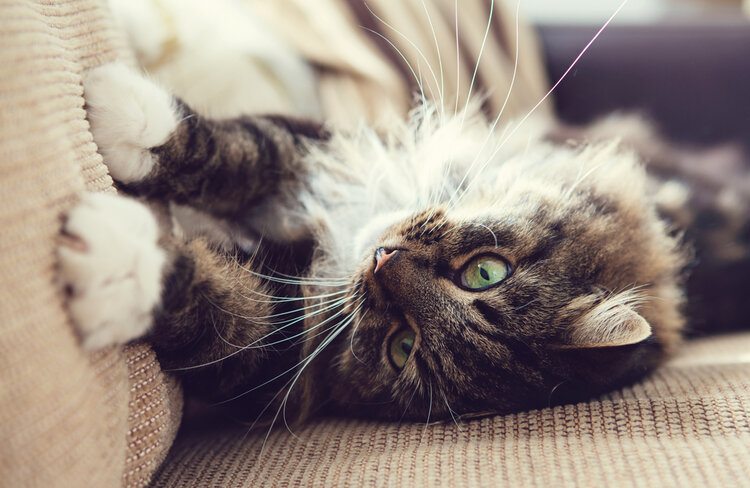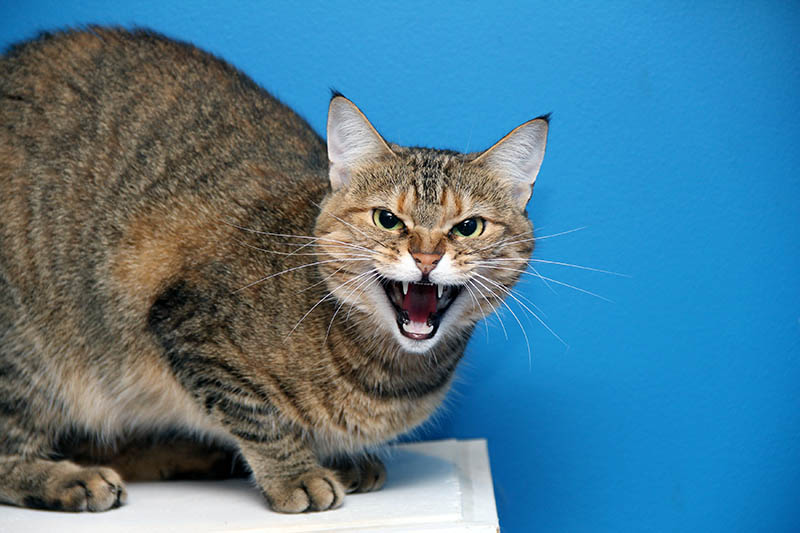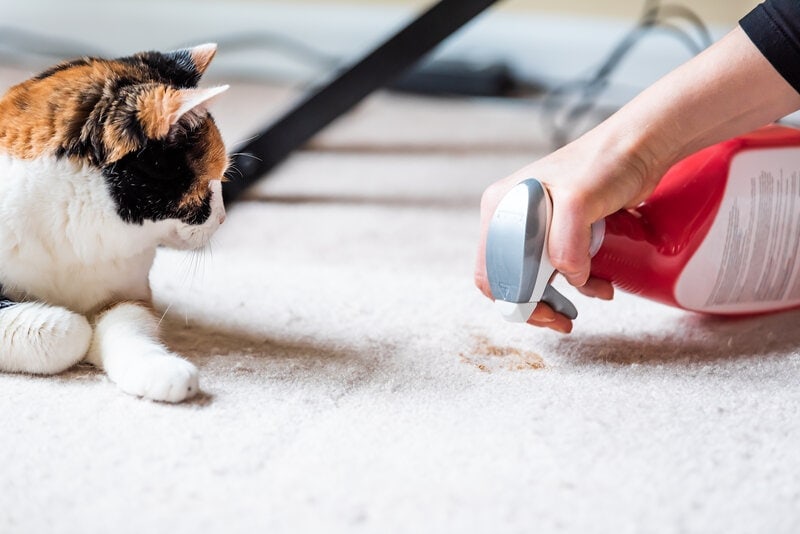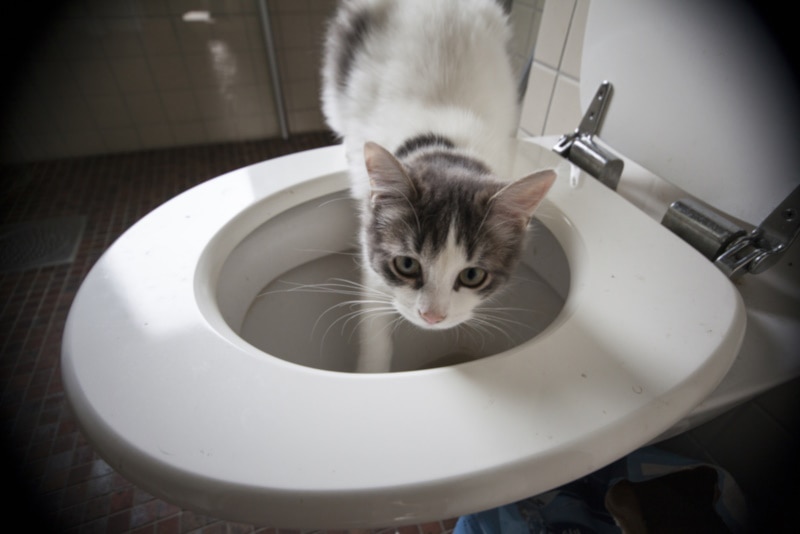5 Common Behavior Problems in Cats: Advice & Facts

Updated on

Behavioral problems in a cat can either result from environmental stress or an underlying medical condition. While some are merely expressions of your cat’s instincts, others, like aggression, inappropriate elimination, and over-grooming, could be rooted in a health-related issue.
Your cat experiences emotions such as fear, frustration, anxiety, and pleasure, which can positively or adversely affect its behavior. Many cat behavioral problems are undesirable and will reflect on the quality of life for the pet and their owners.
Fortunately, not all behavioral problems warrant vet visits for a medical examination or a specialist for therapy as you can correct some of these. Here are five common behavior problems in cats, along with tips and tricks on what you can do as a remedy.
How to Identify Normal Cat Behavior
Every cat is different with a unique personality that the owner should know better than anyone, and it is not challenging to identify behavioral problems. Like humans, cats are creatures of habit, but while any changes in behavior will be easy to spot, they are highly secretive.
For instance, your cat will conceal an illness until deathly sick, so you must identify normal behavior to address any changes and rectify the problem. It’s normal if your cat shows territorial instincts such as scratching or spraying urine, similar to how it will act aggressively toward strange cats.
But even when this behavior is normal, you do not want to encourage your indoor cat to scratch furniture or spray urine on your walls. You want peaceful co-existence with your cat in ways that make both of you happy while respecting rules and behavioral boundaries.
Some cats, especially young ones, may not know the difference between acceptable and unacceptable behavior. However, many pet parents experience behavioral problems with their cats, especially as there may not be a single reason behind a particular issue or change.

The 5 Common Behavior Problems in Cats
1. Furniture Scratching
Cat scratching is one of the most common behavioral problems that pet parents complain about, and it can lead to severe furniture damage while affecting the cat-owner relationship. Targeted items usually include sofas, rugs, chairs, and drapery.
However, this is normal behavior for the cats to some extent. A cat will instinctively scratch to deposit pheromones from the paws as a territory-marking behavior or to sharpen its claws. Scent marking makes them feel more secure in their environment, and scratch marks are visual messages to other cats within that area.
But since you would rather your cat did not tear up your furniture, you must provide constructive outlets for this behavior. Give your furry friend scratching posts or trees around the house and encourage their use with pheromone products or catnip.
Mix vertical and horizontal scratching posts of different materials such as sisal yarn, cardboard, and linen fabric. Also, ensure that these posts are tall enough and located where your cat can access them, especially since they love to scratch while stretched out.
2. Litter Box Issues
Inappropriate elimination is when your cat decides not to use their litter box and instead goes to the toilet in another part of your house. Although you’ll come across pee and poop in shoes, clothes, and the bathroom or on your bed, your kitty isn’t doing this out of spite.
Cats are finicky and fastidious, and not using their provided facilities is a sign that they are not happy with the conditions of a litter box. Your cat may also be spraying urine to mark its territory and calm itself with self-scenting, which can be increased by stress.
- The litter box is too small. Get a larger size-appropriate box.
- A dirty litter box that’s not scooped regularly. Scoop often and offer two boxes.
- The litter box is in a high-traffic area of your house. Put the litter box in a more private place.
- The dominant cat is not sharing the litter box. Get more than one litter box.
- The cat has a medical condition, such as an inflamed bladder or constipation. Consult your vet for a diagnosis and subsequent treatment.
Wondering whether an enzymatic spray or deodorizing powder is better at fighting pet odors? Compare our Pet Stain & Odor Eliminator Spray to our Deodorizer Powder to see which product is best for your deodorizing needs.
Hepper Bio-Enzyme Pet Stain & Odor Eliminator Spray
Hepper Advanced Bio-enzyme Deodorizer & Litter Additive
Eliminates smells
Works inside your cat's litter
Removes stains
Works on contact
Works on a variety of surfaces
Unscented
3. Excessive or Uncalled for Aggression
Several reasons can cause your cat’s aggressiveness, including stress, fear, anxiety, overstimulation, and illness. It’s normal for a cat to appear aggressive against other animals, whether cats, dogs, or any wild interloper, a throwback to its wild ancestors.
Introducing a new cat while your resident kitty is an adult requires specific measures for integration to avoid negative interactions. Cats also lash out at humans due to overstimulation, loud scary noises, or seeing something like a dog outside that makes them anxious.
You can avoid these situations by preventing stimulating instances. For instance, seclude your cat when a neighborhood stray walks by or hangs outside the window. Positive reinforcement also works well if you feel your cat’s acting out, but you must do so calmly to de-escalate the situation.
If your cat is acting aggressive when you’re petting it, watch out for cues such as ears turned sideways and tail thumping, which means it’s time to stop. Besides respecting such signals, back away if they start growling or hissing while avoiding eye contact or diffusing the tension with toys and treats.
At other times, your cat may exhibit aggressive play with scratching and biting, which is part of normal feline behavior. While that’s a mild form of aggression, interactive outlets of this behavior, such as wand toys that move, will satisfy these wild instincts.

4. Jumping on Countertops
High places attract cats as they serve as resting spots and lookouts, making them feel safe and secure from unwanted attention, such as nosy dogs. Countertops are specially chosen due to the presence of food and cool water faucets or for the chance to gaze out a window.
Your cat’s countertop jumping behavior can interfere with meal preparation. The cat could mess up the space by tipping over jars, cups, food, and other items.
Start by removing the temptation, which includes foodstuffs or dripping water faucets to discourage your pet from climbing up there.
Create an alternative climbing spot higher and more ideal than a countertop to redirect the need to perch up high. If they’re using that surface as a route to a higher place, give them access using climbing trees or posts, and set it up using treats, a hammock, or a cat heating pad.
Use a window film to obscure the spot they’re gazing out of, or add a cat shelf in another location away from the counter. Provide a water fountain for running water, which is preferable for felines.
Once your kitty has a better perching spot, the allure to jump up the countertops will decrease.
5. Vocal Meowing and Yowling
Your cat’s vocalizations are normal when they seek your attention, want food, or go outside, but you should be concerned about excessive yowling or meowing. While there are cat breeds known for being more vocal than others, a typical behavior can be indicative of issues such as being on the heat if the cat is not spayed or neutered.
Howling can also indicate senility or dementia in elderly cats or a medical condition causing pain or loneliness. Excessive vocalization can also be caused by hyperthyroidism, hypertension, hearing or vision failure, or anxiety.
Additionally, cats are nocturnal, or more specifically, crepuscular creatures, meaning they actively hunt between dusk and dawn. You can add to playtime with toys and enriched activities that stimulate their brain or talk to your vet if you suspect a health-related issue.
For instance, a cat vocalizing while eliminating could suffer from painful constipation, a urinary tract infection, bladder stones, or tumors. Besides other causes of pain, such as a tail pinched in a door or the results of a catfight, have your pet checked by a vet for diagnosis and treatment.
Conclusion
A cat showing behavior problems requires patience and understanding since they indicate something wrong to warrant your attention. Avoid placing unnecessary stress on your pet by using punishment as a deterrent for behavioral changes or ignoring the issue and hoping it goes away.
Redirection or providing alternatives and outlets will solve many common behavior problems in cats, but others may require immediate vet intervention and medical attention. Changes in their environment, anxiety, stress, or pain are some issues you can solve for your cat without considering rehoming.
See Also:
- Hypertension in Cats: Signs, Causes & Care (Vet Answer)
- Top 29 Cat Behaviorists: Extraordinary Feline People (Update)
Featured Image Credit: Magdanatka, Shutterstock













